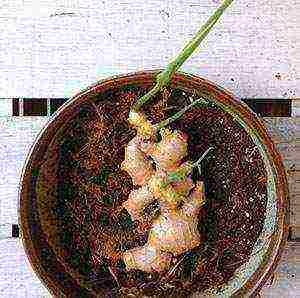Content
- 1 Soil composition
- 2 Lighting rate and temperature
- 3 Irrigation scheme and air humidity
- 4 Required feeding
- 5 Pests and diseases
- 6 Care secrets
- 7 Useful Tips
- 8 Video: how to plant tuberous begonia
- 9 Begonia care - recommendations
- 10 How to grow begonia from a tuber at home
- 11 How to protect begonias from diseases and pests
- 12 How to properly store begonia tubers
- 13 general information
- 14 Growing rules and reproduction from a tuber
- 15 Care after disembarkation and reproduction
- 16 Possible problems
- 17 Landing nuances
- 18 The subtleties of growing
How to grow begonia at home? Basically, it's not difficult. The plant is a little capricious in terms of ambient humidity. The rest of the care is close to the standard requirements of the usual indoor flowers.
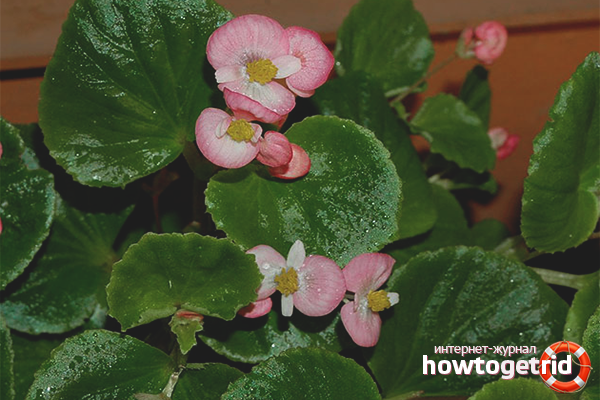
The classic set of points about growing begonias includes just a few common questions. They are all very ordinary. Let's consider them in order, and, following our recommendations, you can admire the beautiful flowering of a gorgeous plant for a long time. Here is a list of questions:
- soil composition
- lighting and temperature rate
- irrigation scheme and air humidity
- required feeding
- pests and diseases
- care secrets
As you can see, there is nothing extraordinary. Let's start.
Soil composition
Begonia loves fertile land, but always loose. You can buy it at a specialty store. But it will be safer to mix it yourself. To do this, take in equal proportions humus, garden leafy soil and peat. Mix thoroughly. For one medium pot, add a handful of clean coarse sand and a small handful of earth from under the conifers. That's it, you can plant begonia. The tuber is not completely buried in the soil. It should stick out above the surface by half or even a third of its height.
By the way, about the pot. Some people prefer only clay or ceramic. On the one hand, this is good. Such material absorbs moisture, which prevents the soil from drying out quickly. On the other hand, begonia roots very often grow to the walls of the pot and are severely injured during transplantation. Therefore, it is still recommended to take a plastic pot.
And do not forget to be sure to pour drainage at the bottom. Any container. It can be expanded clay, pebbles, gravel, granite chips. Not limestone or eggshells. Over time, they deoxidize the soil, and begonia does not like this.
how to properly care for begonia
Lighting rate and temperature
Begonia loves a lot of light. So many. But at the same time, when direct sunlight hits the leaves, burns often occur. What to do? There are only two ways out:
- Place the plant in the back of the room, where the direct sun will not fall on it. Then you will have to constantly illuminate it with special phytolamps or daylight. Moreover, all year round.
- Place the begonia on a brightly lit windowsill. Be sure to shade it from direct sunlight with white paper, curtain, cardboard.
In this case, it is important to monitor the air temperature. It should not fall below +14 and rise above + 26 ° С. In summer, it will ideally contain begonia at + 22-24, and in winter at + 7-9 ° C.
Why is there such a spread? Because winter is the hibernation season of begonias, a period of rest.If you ignore this point and do not put the plant at rest, then foliage and stems will delight you. You will not see flowers at all.
how to grow a date palm from seed
Irrigation scheme and air humidity
There is no specific scheme for precise watering. There is an immutable rule: water when the top layer of earth in the pot dries out to a depth of 1.6-1.8 cm. There is no firm understanding of “watering”. There is a slightly "moisten the earth". Excessive moisture stagnation is detrimental to begonias. She immediately reacts with violent decay of roots and growth points. To prevent such an unpleasant situation, there was a requirement to use expanded clay.
An additional signal may be excess water in the pan. It must always be drained, and the pot is placed on dry loose napkins or soft rags (rags) for 14-16 minutes. During this time, all the liquid is absorbed.
By the way, you can't just take a mug and pour water into a pot. Watering begonias should only be along the edge of the pot, being careful not to get water into the growing point.
Begonia is very demanding for air humidity. She likes the air around her to be saturated with water. At home, this is achieved very easily:
- Every day, the leaves are abundantly sprayed with clean, warm, settled water.
- A low stand is placed in a wide pallet (you can turn the saucer upside down). The remaining space is covered with expanded clay, moss or peat. Very generously moistened to the "afloat" state. And already a pot of begonia is placed on the stand.
Thus, the air around the flower will always have the required humidity. Just do not forget to periodically add it to the pallet.
Advice. You can take a long, narrow tray over the entire window sill and put together a whole collection of your favorite begonias on it. Simultaneous flowering will be simply mesmerizing.
By winter, watering begonias is practically reduced. Water it every 9-11 days without excessive moisture. At the same time, they stop spraying the air around. Because the underground part of the plant has enough water in the soil. And the aboveground in the cold season is no longer there.
how to grow cyclamen from seeds
Required feeding
Begonia grows almost from scratch every spring, manages to gain mass and release buds in a short time. Then she blooms gorgeous with huge lush tassels. Accordingly, she needs a lot of food. Most often it is mineral water. Only choose the one where there is a high content of phosphorus and a low content of nitrogen.
In this case, the solution is made twice as weak as recommended on the package. But they feed the plant every week. It starts with the first sprout and ends with the first yellow leaf in the fall. With the onset of flowering, nitrogen is completely excluded from the diet of begonias. You can choose the right fertilizer yourself, or you can ask the seller in the store. They will be happy to tell you which one is most suitable for your pet.
Advice. Organic begonia is not fed. She has enough of what is contained in the planting soil.
how to grow bonsai at home
Pests and diseases
The most common pests on the plant are whitefly, aphids and spider mites. With the first, there is a life-and-death struggle. It is useless to poison it with chemicals. To get rid of the whitefly, you need a whole range of measures. Look for information on the net or reference books what kind of attack it is and how to defeat it.
The latter are quite commonly killed by any suitable systemic fungicide. You can safely spray, rinse and wash the leaves and stems with poison. After all, you do not need to eat them. Just be sure to then dry the flower as thoroughly as possible to avoid the appearance of ugly brown spots.
Advice. After the initial treatment, the pet is placed for 9-10 hours in a tight plastic bag along with a pot. Perhaps, after such a procedure, a second chemical treatment will not be needed.
Diseases. Begonia practically does not get sick.This is what attracts many lazy breeders. But, with excessive watering and an excess of moisture in the ground, rot or powdery mildew may still appear. At the first sign, urgent measures must be taken, otherwise the begonia will die very soon:
- replace the top 3 cm of soil with dry
- if possible, it is better to transplant the plant altogether
- if the defeat has just begun, then carefully cut off the decaying place, then burn it with brilliant green
- wash leaves from powdery mildew with a weak stream of warm water
- reduce watering for a while
- raise the lower leaves so that they do not touch the soil
If these measures do not help and the disease spreads further, then you will have to grow a new plant. To do this, either cut healthy cuttings and root them (for leaf forms and bush forms). Or they pull the tuber out of the ground, remove all damage and plant it in a new pot (for tuberous forms).
Of course, this is insulting and takes a long time. But then there are requirements for irrigation conditions. If you follow them exactly, then such problems can be avoided.
how to grow lemon
Care secrets
The biggest secret of begonia is to make it bloom. For this to happen, you will have to send the plant to rest. To do this, at the end of summer, watering and feeding are gradually reduced. By October, they are completely stopped, and the flower itself is placed in twilight. After about 27-29 days of this content, all nutrients from the stems and leaves are completely transferred to the root. They can now be cut completely. The pot must be stored under the conditions described above.
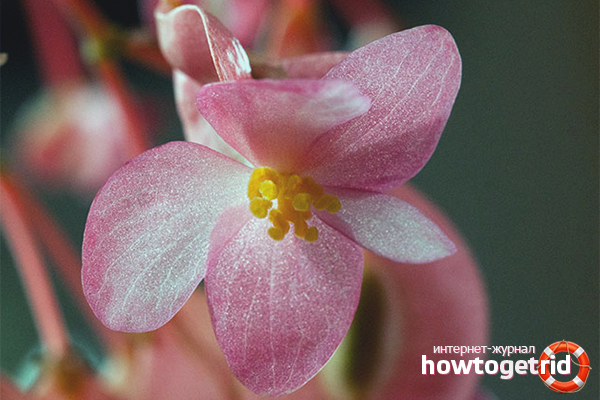
From the beginning of February, begonia is transferred to a sunny place with an elevated temperature. Waiting for the first sprout to appear. And then the recommended care follows. By the way, winter flowering begonias do not have a dormant period. Therefore, first figure out what kind of plant you have. Otherwise, you can dance with a tambourine around, but there will be no flowers.
Another secret is disease prevention. For this, the planting soil must be calcined in the oven or kept in the freezer for at least 2 days. Then, periodically (once a month) phytosporin is added to the irrigation liquid. The proportion is three times less than according to the instructions. And lastly, begonia should not have leaves in contact with the soil. For this, a special circular support made of plastic or wire is placed in the pot, the leaves are laid on it. Or they simply cut off the lower ones when 6 leaves appear on the stem.
With strict observance of all conditions, your pet will not get sick at all.
The third trick is the annual transplant. In February, the tuber is removed from the old soil, soaked in a weak solution of potassium permanganate. 14-16 minutes will be enough. Then the small roots are carefully unraveled with a wooden stick. If necessary, remove dried and rotted during the rest period. Air-dry for about 40 minutes. Then they are planted in a new land. In this case, the pot can be taken a slightly larger diameter, about 1 cm.
If you have a miniature begonia, there is no need to increase the planting capacity.
how to grow a money tree
Useful Tips
- Do not plant the tuber in an oversized container. In this case, even with the most excellent care, begonia will build up a lush green mass. It will not bloom.
- By the way, in order for the flowering to be long-lasting and effective, it is imperative to remove all faded buds and dried flowers in a timely manner. Otherwise, the forces of the plant will be used for the formation and maturation of seeds.
- Have you missed and the seeds have already appeared? Take your time to pick off the box. Collect them and sow them in January on a nutritious loose substrate. Just don't put it on top. Better to cover the box with glass or transparent plastic. Seedlings appear within 2-3 weeks. After 2 true leaves, cut the plants into separate cups and spray more often. If you do everything right, then you will have not one, but several completely independent plants.
- Sometimes begonia leaves begin to turn yellow before September. It could be soil depletion - feed the plant. Lack of moisture - spray the air around and moisten the ground often. The presence of pests in the roots - change the soil mixture completely. Before transplanting, treat the open root system with any insecticide and manually remove any visible enemies.
We hope that after reading our tips, you will not have any more questions on how to grow begonia at home. Now you know the main secrets and you can easily keep this beautiful and grateful plant at home.
how to grow violets at home
Video: how to plant tuberous begonia
Begonia Picotee Arlequin
Begonia care - recommendations
The main requirements for caring for bulbous begonia are reduced to maintaining a sufficiently high temperature and humidity of the soil, as well as air. If you know how to properly plant and grow begonia tubers, you can get a real home flower garden that can always cheer you up and bring a fresh touch to the atmosphere at home.
The soil
In order to understand how to plant a tuberous begonia indoors, you should pay special attention to the composition of the soil. For beginner flower growers, it is advisable to purchase a special primer. If you have confidence in your abilities, you can make it yourself from the following components:
- 2 parts of peat;
- 2 pieces of leafy land;
- 1 part coarse sand.
Another option:
- 3 pieces of leafy land;
- 1 part of sand and peat;
- and some more humus.
If there is no peat at all, it can be replaced with the same amount of coniferous soil. In any case, it will be correct to add 2 handfuls of charcoal.
NOTE
In order for the planting of tuberous begonias to be successful, you should not put leafy soil taken from under a willow or oak in the pot. Such soils contain an excessive amount of tannins, which will adversely affect the development of the plant.
Fertilizers
Another important rule of caring for tuberous begonia is the addition of fertilizers during the flowering of the plant (you do not need to add anything when planting). Basically, they choose mineral supplements, for example, "Kemira Lux". The tool is used according to the instructions. The application mode is as follows:
- 1 time during the formation of buds;
- every 2 weeks during flowering;
- the last time - immediately after the end of flowering.
NOTE
Top dressing can be applied more often, but then the concentration should be reduced by 2 times relative to that indicated in the instructions. The need for weekly fertilization may arise during the flowering period if the plant's appearance is not healthy enough.
Temperature and illumination
When planting a tuberous begonia, you need to take into account that it is better to choose a western or eastern window for its cultivation. If this is not possible, it is necessary to create conditions for diffused light - for example, using a tulle curtain.
The optimum temperature for different plant varieties is 20-25 ° C. The flower will withstand higher temperatures if the air is humid enough. Growing begonias from a tuber at home requires a temperature of at least 22 ° C. At the same time, a decrease below 17-18оС is unacceptable - the plant can be seriously damaged.

NOTE
If a lot of light comes in on summer days, it is better to put the begonia pot on a table next to the window. The florist's task is to create a bright, but at the same time indirect, i.e. diffused lighting.
Watering and humidifying the air
When caring for tuberous begonia, it is important to always remember that the homeland of this plant is the tropical belt of Africa, America and Asia. Intensive watering is one of the basic rules for growing and proper care for all varieties of tuberous begonias. The flower is watered immediately after planting, and then watering is carried out several times a week. At the same time, the following recommendations are observed:
- The volume of the liquid and the mode of its supply are determined by the state of the soil. It should be moderately damp to the touch.
- An excessive amount of moisture is unacceptable, as this will lead to root rot.
- Watering is done carefully so that the liquid does not get on the flowers or leaves.
- It is better to pre-settle the water for several hours to room temperature. Too hard water must be softened with special filters.
As for humidifying the air, it can be done with a spray bottle, and with damp stones or a damp cloth in the pallet. If the air in the apartment is too dry, you can use a special humidifier.
NOTE
If the buds fall off, the leaves curl, and in general the plant has a sluggish appearance, this clearly indicates insufficient watering. The volumes of liquid should be increased by 1.5-2 times and the air next to the flower should be regularly humidified.
How to grow begonia from a tuber at home
Regardless of the specific variety, the technology of planting and growing begonias from a tuber is the same. It is important to pay attention to the processing of planting material, selection of soil and pot. They begin to work in March, so that in May-June the plant will please with its lush flowers.
If you listen to useful advice on how to plant a begonia with a tuber, then it will not be difficult to breed this beautiful plant at home.
Planting tuberous begonia - step by step instructions
- First of all, it is important to pay attention to the appearance of begonia tubers and their size. The diameter should be 3 cm or more. The tuber should be dense enough, its surface after cleaning - smooth, without irregularities and defects. If it is too large, it can be cut in half and charcoal sprinkled over the cut.
- Immediately before planting, the surface is completely cleaned of dirt and dead roots.
- Then they are treated with any fungicide (for example, "Discor", "Maxim") or 1% solution of potassium permanganate (hold for half an hour).
- Pick up a pot from any material. It should be 15-25 cm deep and 2 times smaller in diameter. Any small stones or expanded clay (up to a third of the height) are laid on the bottom.
- Then they fill it almost to the top with soil, and in the middle it is necessary to make a small hole (one third of the finger).
- Then they actually start planting begonia tubers. It is laid with the concave side up, convex - towards the ground.
- Finally, you need to sprinkle it with earth. Moreover, the upper third should remain above the surface of the soil - sometimes the sprouts can rot if the surface is completely closed.
- After planting, the pot should be watered immediately and placed in a warm place where the temperature will not drop below 22 ° C.
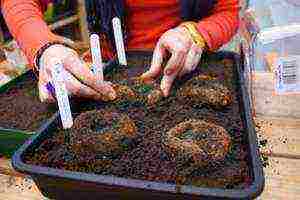
Watering should be done regularly so that the soil is always moderately moist. However, excess moisture is also harmful, and this should also be taken into account. The first shoots will appear after a week, and in a month there will be 2-3 large leaves on the shoot. And after another month, begonia will give beautiful flowers.
How to protect begonias from diseases and pests
Planting begonia tubers at home is quite simple if the soil is selected correctly, and the temperature and watering conditions are met. In the future, as the plant develops, diseases associated with pests (aphids, spider mites, nematodes) or with improper care (insufficient light, excess or lack of moisture, etc.) may appear.
Begonia diseases: causes and how to eliminate
The most common developmental disorders associated with improper conditions of detention and infectious pathogens include:
| outward sign | cause | solution |
| leaves dry at the edges, begin to curl | dry and hot air | rearrange to a cooler place, periodically humidify the air |
| leaves fall off or turn yellow and wither | too cold | rearrange to a warmer place |
| foliage wilted | polluted air or lack of moisture | take the pot to another room, water abundantly (if the ground is dry) |
| leaves grow small, flowers do not form or flowering is rare | lack of fertilizer | fertilize the soil with organic or mineral fertilizing |
| leaves fade, cobweb found | spider mite activity | use an insecticide or infusion of onions (more details below) |
| powdery coating with greenish and brown tints | gray mold fungus activity | spray with fungicide (benomyl) according to the instructions and put the pot in a dry, cooler place |
| white spots of a powdery consistency | powdery mildew activity | |
| the roots turn black and rot | black root rot fungus activity | stop watering, spray with fungicide, remove to a drier place |
| rot on the surface of leaves and flowers | waterlogging | reduce watering, prevent moisture from spraying on the begonia itself |
| leaves are deformed, yellow spots appear on the surface | activity of the cucumber mosaic virus | destroy the flower, disinfect the pot, replace the soil |
| the leaves have lost their color, on the roots there are influxes | nematode activity |
Pests and how to deal with them
As for the pests of royal begonia, the most dangerous are:
- Spider mite is a rounded insect, bright red in color, less than 1 mm long. They look like numerous bright spots on the surface of the leaf and stems. Leaves cobwebs throughout the plant.
- Aphids have different colors (green, gray, brown), the shape of the body is rounded, 2-3 mm long. They look like numerous gray dots.
You need to deal with them immediately after detection. For this, special insecticides are used, which can be purchased at a specialized store:
- thiophos;
- karbofos;
- actellik;
- neoron;
- fitoverm;
- fufanon.
They act clearly according to the instructions. You can also use a home remedy based on regular onions (with brown hulls):
- Chop the onion very finely or pass it through a meat grinder.
- Take a full teaspoon (half a tablespoon) and infuse for 1 week in a liter of water.
- Strain and spray the foliage and stems until the insects are completely destroyed.
PREVENTION TIP
The foliage and especially the stems of the plant that are hidden under the bush must be carefully examined for the presence of these pests and other lesions. The sooner you start dealing with them, the higher your chances of success.
How to properly store begonia tubers
It is important to know not only how to plant begonia correctly, but also about the secrets of successful storage of tubers in winter. The most important thing is to take into account a few simple tips that will allow you to preserve the material well:
- Initially, all tubers are carefully inspected in order to immediately remove damaged material.
- The storage temperature should be above zero, but at the same time not more than + 9 ° C. Otherwise, the tubers begin to sprout.
- Even a small amount of moisture on the material is not allowed. If possible, it should be stored in a dry place.
For planting and propagation of tuberous begonias, the material can be stored in basements or at home.
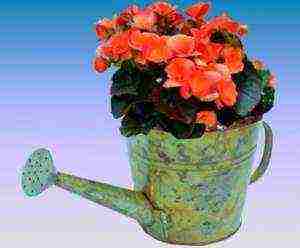
Storage in the apartment
In the apartment, you need to find the coolest place - for example, under a window or under a balcony door. The temperature is checked in advance (so that it is constantly in the range of 0-9 ° C). There are three storage options:
- In a box or box in bulk. Tubers are placed, completely covered with sawdust, dry peat or sand.
- In pots - they are transferred to a cool place, while the upper part is cut off with a sharp knife flush with the ground. Water the soil occasionally to keep it slightly damp (no drying out).
- If the apartment is warm enough, and there are no cool places in it, you can save the tubers of tuberous begonia for further planting and in the refrigerator. The material is dried, placed in bags with holes and covered with sawdust, or each tuber is wrapped in paper.Store in the door or at the bottom of the refrigerator (in the same place as vegetables and fruits).
NOTE
If the tubers will be stored in pots, it is better to water them through the drip tray to avoid possible rotting.
Basement storage
If you have access to a sufficiently dry, cool basement, you can store the tubers there as well. They are also placed in a cardboard box or wooden box, covered with peat, sand or sawdust so as to completely hide. It is important to understand that the cellar is definitely not suitable for such purposes. As a rule, the humidity in it is always high due to the proximity of the ground, which will lead to rotting of the material.
Thus, the question of how to plant begonia with tubers has a simple and clear answer. If you follow the step-by-step instructions discussed above and follow the tips for caring for the plant, all the tubers will definitely sprout. And very soon the plant will delight you with its beautiful, cheerful flowers.
INTERESTING TO KNOW
In 2016, begonia was named Bulbous Plant of the Year. In fact, it is a tuberous plant. The fact is that tuberous plants belong to the group of so-called bulbous plants (geophytes), but real bulbs store nutrients in underground leaves. In tuberous plants, fleshy thickened roots - tubers - serve for these purposes.

Begonia is a herbaceous plant that has a developed and thick root system and beautiful inflorescences. It has gained great popularity not only among gardeners, but also lovers of beautiful flowers. It can be grown using seeds or tubers, but the second option is the simplest.
general information
Tuberous begonia has a thick tuber, translucent thin stems, and large juicy green leaves. The plant can grow up to 80 cm in height, depending on the cultivar and its lifespan. His leaves are arranged in order of priority, while they can have an asymmetrical or heart-shaped shape.
During flowering, simple or double inflorescences of different colors appear on the plant - bright red, snow-white, orange, yellow. But at the same time, they cannot have a purple, blue or blue tint. The most common begonias for growing in the garden, as can be seen from the numerous photos of gardeners.
On one plant there are different inflorescences - female and male. When additional pollination is carried out, seeds appear in them. In winter, the plant sheds its leaves and remains dormant until early spring. Therefore, if the cultivation is carried out in the garden, they need to be dug up and insulated.
Tuberous begonia has a thick tuber, translucent thin stems, and large juicy green leaves
Currently, gardeners have about 900 varieties of begonias, while due to the work of talented breeders, more than 2,000 hybrids have been bred with different colors and shapes of flowers, which can be seen from the photo. They can be grown in the garden and at home, but for this it is important to know the subtleties and rules.
Among the varieties of begonias, three main groups can be distinguished:
- tuberous;
- bush;
- sheet.
Among gardeners and lovers of beautiful flowers for home cultivation, the most popular species is the ornamental-deciduous tuber. It has luxurious inflorescences and lush succulent leaves.
Growing conditions video
Growing rules and reproduction from a tuber
For propagation of a plant with tubers, planting material can be selected purchased
Many are faced with the question of how to grow begonia from a tuber. Basically, hybrid varieties are propagated in this way. In contrast to growing a plant from seed, this method is simpler and easier to implement. Tuberous begonia can multiply:
- leafy cuttings;
- tuberous cuttings.
The first method is carried out in the spring, for which the stem or leaf is cut off and carefully buried in well-moistened soil. The second method is tuber cultivation, which is mainly carried out in the fall.
For propagation of a plant with tubers, planting material can be purchased purchased. To do this, when choosing it, it is important to pay attention to its appearance. The planting material should be even, dense and dark brown in color. In this case, any light or green spots will indicate the presence of a disease.
Reproduction of garden begonia is carried out as follows:
- In autumn, tubers are dug out of the soil in the garden and cleaned of dirt and soil.
- Stalks are cut from tuberous cuttings and stored in the ground, care is required at a temperature of 8 to 10 degrees.
- At the end of winter, at home, tuberous cuttings are transplanted into well-moistened soil.
- Growing sprouts takes several weeks, during which moderate regular watering and careful maintenance is required, including monitoring the ambient air temperature and wind, which can damage the plant.
- When shoots appear, tuberous begonia needs to be cut into two parts, while the sections of the cuts require additional processing with charcoal and drying in order to prevent a possible decay process. When dividing, it is important to cut the bulb into two parts, each of which will have a bud to resume growth. You can see the result of cropping from the photo.
- Divided cuttings are planted in boxes filled with moistened soil. They need to be deepened into the soil only half the length. You need to bury it very carefully so that the leaves do not come into contact with the peat, otherwise this can lead to their decay.
- After 15-20 days, they can be transplanted into pots with high-quality peat and fertilizers, as well as a lower drainage layer - small gravel or expanded clay. Without transplanting, the leaves and flowers begin to fade and become very dry. Caring for the plant in this case includes feeding with organic fertilizers and providing a sufficient amount of sunlight.
For transplanting, it is important to choose the right pot, since it should not be spacious or cramped. It can be ceramic or plastic, in the latter case, it is imperative to lay out a layer of expanded clay, since it will draw in excess moisture in the pot. After drainage, a layer of sand is filled up.
Peat should be moistened during transplanting, but it should not be very moist. The optimal choice is nutritious slightly acidic soil. You can buy peat for transplanting ready for growing flowers, as well as prepare it yourself. At home, you can mix sand, peat, foliage and humus.
Video about planting a tuber at home
Royal begonia reproduces in a similar way, home care without any problems even an inexperienced gardener can carry out with the help of a step-by-step photo and video of the planting and reproduction process. After transplanting the plant, it should be cut off, which will allow it to recover as quickly as possible and actively resume growth.
After transplanting, the plant must be sprayed every day with clean water using a spray bottle, which will help to avoid waterlogging of the soil. It is better to keep it in a dark place for several days.
Care after disembarkation and reproduction
Begonia can tolerate shade and light well, but this depends on the variety. Plants with large inflorescences like to be in a semi-shaded state, and with small ones - in the sun. Similarly, ampelous begonia adapts to sunlight - the secrets of successful cultivation of which are similar to tuberous ones:
Growing a tall plant with large inflorescences in the garden is carried out in an area where there are no strong winds (for example, with protection from shrubs and trees). Strong gusts of wind can easily break thin stems;
Since this type of begonia has a hybrid origin, care can be complicated, since different varieties have individual adaptations to a certain temperature regime. Almost all begonias are thermophilic plants, especially varieties with large leaves and inflorescences. Therefore, their care must be appropriate. Plants of the tuberhybrida group are most adapted to the coolness, capable of blooming at an ambient temperature of about 10 degrees;
In the fall, it is important to reduce watering, cut and remove dead shoots.
All varieties of begonias do not tolerate frosts and strong cold winds, in which the leaves of the plant begin to darken, which can be seen in the photo. Therefore, care should include protection from low temperatures, including shelter and insulation for the winter. In the fall, it is important to reduce watering, cut and remove dead shoots. If begonia grows in the garden, then it should be dug out of the open ground closer to the onset of frost, which will start the growing season;
Tuberous begonia does not tolerate extreme heat and dry weather, as a result of which the plant's flowering and root growth stops.
It is also worth noting that all plant varieties, including indoor begonia - care and cultivation of an amazing flower requires careful watering. With a lack of water, the inflorescences will fall off, and the leaves will stop growing. But excess liquid also negatively affects the plant, as it leads to the appearance of rot.
Watering after transplanting should be moderate, otherwise the tuberous begonia can rot and stop growing. Watering is carried out only when the topsoil dries out. Such care will ensure rapid growth and good condition of the plant.
Video clip about breeding and care
Possible problems
Growing begonias requires careful maintenance, which includes watering, ensuring adequate sunlight, and controlling pests and potential problems. Very often the plant affects:
- Powdery mildew. Appears due to high humidity and abundant watering. In the photo, it looks like a whitish coating of flour.
- Gray rot. Formed at high humidity and low ambient temperatures. In the photo, it resembles mold of a dark or light gray shade.
Growing begonias also involves being mindful of light and temperature. Since a lack of sunlight can lead to yellowing of leaves and inflorescences, and low humidity can lead to dropping of buds. It is important to observe moderate lighting and watering, the optimal level of humidity, as well as the temperature regime - from 15 to 20 degrees.
Rate the article:
(2 votes, average: 1 out of 5)
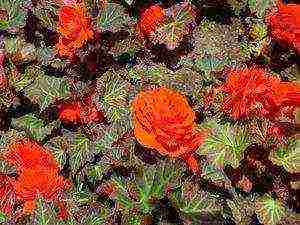 Among lovers of planting home flowers, growing begonias is very popular. It differs from others in a large number of varieties. The texture and shape of the leaves of each begonia is strictly individual; the plant can be painted in a variety of colors.
Among lovers of planting home flowers, growing begonias is very popular. It differs from others in a large number of varieties. The texture and shape of the leaves of each begonia is strictly individual; the plant can be painted in a variety of colors.
The beauty of colors is expressed by their palette and lush appearance. Begonia can be completely monochromatic, or it can have a wide variety of colors.
The plant is about 25 cm long. Growing begonia bushes to get a beautiful garden requires special care, especially at home.
Landing nuances
In order to plant a begonia and minimize the work associated with caring for it, it is necessary adhere to a certain sequence... In the future, this will allow you to achieve good growth and beautiful flowering.
Tuberous begonia is grown in early February and continues until May. The tubers are best planted in slightly damp peat. As a result, begonia will receive the maximum amount of required nutrients. Due to the large amount of peat, the tuber will develop much better.
Each tuber has two sides:
- Rounded;
- Concave.
It is allowed to plant tubers in the soil only round side... Novice gardeners often make mistakes because of the appearance of the tuber and turn it over, planting on the wrong side. Such work of planting a tuber requires care and accuracy.
Planting tuberous begonias should be carried out at room temperature, usually not exceeding 20 degrees, then moderate watering is done. Because of these conditions, tuberous begonia sprouts germinate very quickly. After they reach 5 cm in length, they are transplanted into a flower pot, and its diameter must exceed 20 cm.
The transplanted plant begins to grow vigorously, producing a large number of leaves and flower buds. The plant blooms all summer long and does not wither during the fall. Before the beginning of winter, the leaves fall off the tuberous begonia, it is required to prepare the plant for the winter period.
For this purpose, the leaves are trimmed, roots are taken out... Storage of tubers, roots and leaves should be done in a cool, dark place.
The location of the plant, its lighting
 It will be very good if the tuberous plant is placed near the window, on a flower stand, maintaining the southwest direction. If possible, during the winter cold, it is advisable to transfer the plant all the time to the windows of the south side.
It will be very good if the tuberous plant is placed near the window, on a flower stand, maintaining the southwest direction. If possible, during the winter cold, it is advisable to transfer the plant all the time to the windows of the south side.
It is undesirable to hit the sun's rays on begonia leaves in the summer. They can get severe burns. For this, the window glass is covered with a film, ensuring that scattered sunlight falls on the begonia.
Irrigation system
In order for the plant to always be pleasing to the eye, it is necessary to properly organize its watering. Tuberous begonia, planting and care at home, requires special attention. In the summer heat, the tuber should have abundant watering, the plant should not dry out.
At moderate temperatures, it is enough to water the begonia three times a week, with scorching heat, watering should be daily... This is especially true of the period when intense flowering occurs.
Good watering ensures a strong flowering of begonia, the more beautiful the plant bush will look. It is better to water the plant with settled water.
During watering, water should not come into contact with leaves and flowers. Begonia doesn't like this. There is no need to achieve strong soil moisture. The plant has very delicate roots, so excess moisture can be very harmful.
Before the next watering, you need to make sure that the soil is completely dry. With constant ingress of water on the leaves of the plant, they begin to turn yellow and rot. The plant gradually dies.
When the heat is 40 degrees, to cool the begonia pot, you can put it in a basin for a while, where moist cool pebbles will be poured.
To keep moisture around indoor begonia it is desirable to humidify the airspraying water. After the begonia has faded, the amount of watering is gradually reduced.
What top dressing is needed
This plant is very fond of good fertile land. There should be no lime in the soil. Feeding begonias should be carried out several times a week, starting in summer and ending in late autumn.
Any fertilizer intended for growing indoor plants is suitable for feeding. This soil is sold in gardening shops.
The subtleties of growing
Begonia is a very capricious plant and requires careful maintenance. If this is not done, the plant will not produce a beautiful flower. The problem of proper care is often faced by most lovers of this plant. It's possible identify by the appearance of begonias:
-
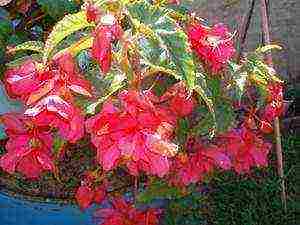 The leaves are dotted with brown spots. This speaks of the burn they received from the scorching sunlight. The flower should be transferred to the shade as soon as possible;
The leaves are dotted with brown spots. This speaks of the burn they received from the scorching sunlight. The flower should be transferred to the shade as soon as possible; - When the sun's rays do not hit the plant, and the brown spots do not disappear, therefore, the plant lacks nutrients, or it suffers from a lack of water. Sometimes, everything happens, on the contrary, the plant is simply excessively "flooded" with water;
- If the leaves begin to dry and then fall off, we can talk about the dry air surrounding the plant. This occurs most often in early spring. At this time, the heating radiators have not yet been turned off and they give a lot of heat. To remedy the situation, you need to do air humidification.
- When the stem is rotting, the amount of watering should be reduced, their volume should be reduced. Remove all damaged flowers and rotting stems.
How to care for a plant if pests appear
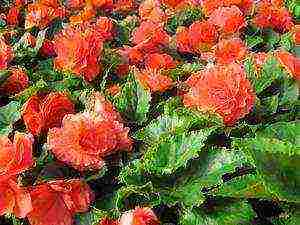 The appearance of pests is associated with improper care of room begonia.
The appearance of pests is associated with improper care of room begonia.
The most dangerous enemy of begonia is considered powdery mildew... Its appearance is caused by abundant watering. To combat this pest, it is necessary to treat the flower with a fungicide. You can also use a simple solution of garlic. To prevent such a disease from affecting your plant, it is necessary to carry out moderate watering, constantly loosen the soil, and ventilate the premises.
Another pest that infects begonia is aphids. The fight against this infection is done manually. For this purpose, each sheet must be wiped with alcohol. You can use a specialized solution sold in stores, such as Homa. Dissolve a teaspoon in one liter of water. With such a solution, only begonia leaves can be treated.
When the indoor humidity is very low, the plant is attacked by spider mite... To combat it, the leaves are treated with chamomile or soapy water. Specialized drugs give a great effect:
- Intavir;
- Karbofos.
How begonias reproduce
The plant can be propagated by seeds or tubers. The finished tuber is divided into several parts. Each of them must have a developed kidney. The finished cut edge is sprinkled with sand. The prepared stalk is planted in the soil, moderately watered. Tuberous begonia, planting and care, requires special care.
A whole tuber can be stored for about five years. Before you start planting it, you need to remove the mold or existing rot marks.
How begonia is transplanted
 A plant transplant is required only if there has been a strong growth of the root system, and it simply does not fit in the pot.
A plant transplant is required only if there has been a strong growth of the root system, and it simply does not fit in the pot.
It is better to replant the plant in the middle of spring. The flower is carefully pulled out of the pot, the roots are cleaned. Then they are dipped in a light solution of potassium permanganate. Stand for about 20 minutes.
Then completely decayed roots are cut off, the cuts are processed with fine charcoal.
Begonia is planted in a large pot, where the mixture is previously poured into the ground. At first, the plant will hurt. Only after a couple of weeks will tuberous begonia begin to take root. In this period requires frequent watering, should not be exposed to hot sunlight. Time will pass, and your home garden will be adorned with beautiful flowers of home begonia grown from one tuber.
Of course, caring for begonias is a painstaking business that requires great care. A very beautiful bloom will be grateful. If you follow all the conditions of detention, you can arrange a whole blooming garden on the windowsill.
